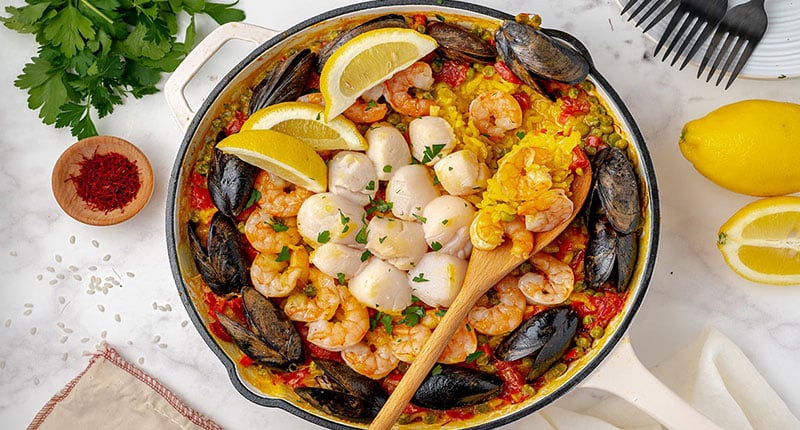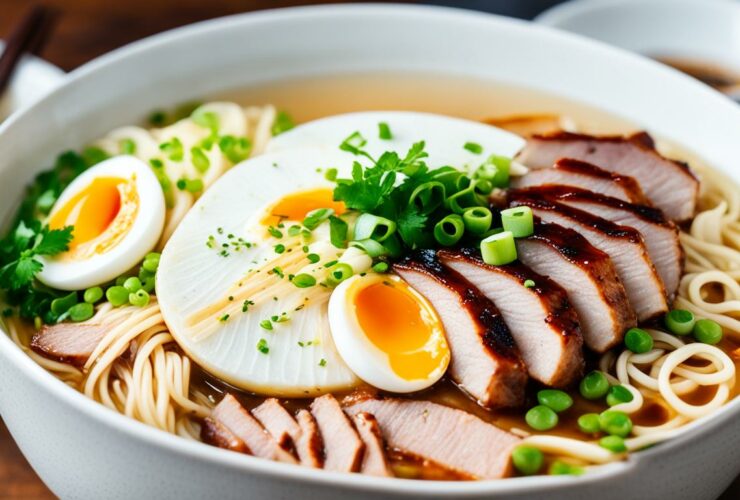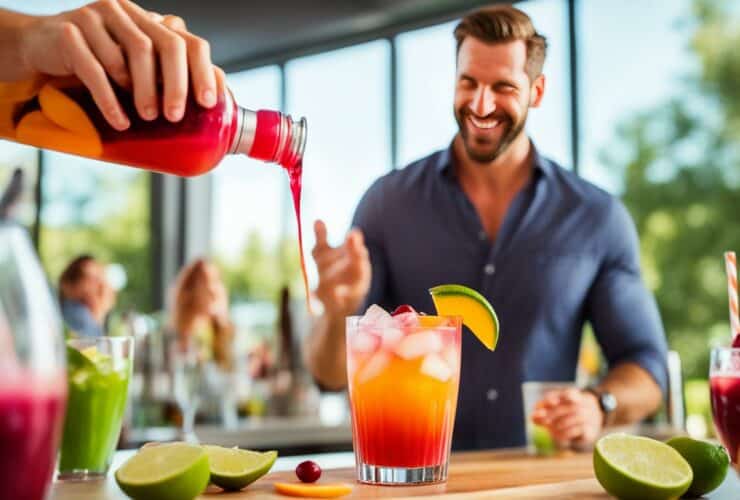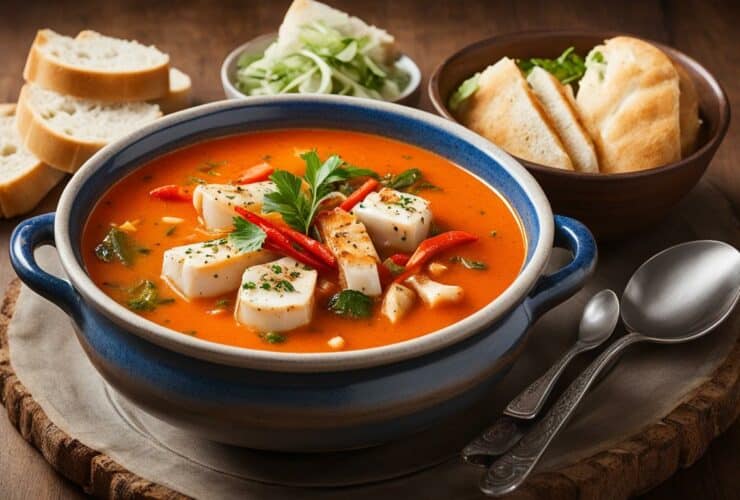Paella is a flavorful and iconic Spanish dish that has captured the hearts of food enthusiasts worldwide. This beloved rice-based dish originated in Valencia, Spain, and it continues to be a symbol of Spanish culinary culture. Mastering the art of cooking paella is an exciting journey that requires a perfect blend of essential ingredients, the right techniques, and a passion for creating a mouthwatering masterpiece. In this article, we will explore the history of paella, the key components of this dish, the cooking process, common mistakes to avoid, variations, serving suggestions, and even some tips for utilizing leftovers.
What is Paella?
Paella is a traditional Spanish rice dish that traces its roots back to the early 19th century in the Valencian region of Spain. The name “paella” is derived from the shallow, wide-bottomed pan it is traditionally cooked in, also called “paella.” This dish has become an essential part of Spanish culture and is often enjoyed in social gatherings, family celebrations, and festivals.
The History of Paella
The history of paella is deeply intertwined with the agricultural traditions of Valencia. Originally, it was a simple and hearty dish prepared by farmers using readily available ingredients like rice, vegetables, and rabbit or chicken. Over the years, as paella’s popularity grew, variations emerged, incorporating seafood and other meats, resulting in the diverse array of paella styles we have today.
Essential Ingredients for Cooking Paella
- Rice Rice is the heart and soul of any paella. The best type of rice to use is short-grain rice, such as Bomba or Calasparra, as it absorbs flavors and retains its shape during cooking.
- Saffron Saffron, the world’s most expensive spice, is responsible for the rich golden hue of paella and adds a distinctive aroma and flavor to the dish.
- Olive Oil High-quality extra virgin olive oil enhances the taste of paella and contributes to the development of flavors.
- Spanish Paprika (Pimentón) Spanish paprika comes in various types, including sweet, bittersweet, and hot. The type you choose will influence the overall flavor of the paella.
- Vegetables Common vegetables used in paella include onions, garlic, tomatoes, green beans, and bell peppers.
- Seafood or Meat Seafood paella typically includes prawns, mussels, clams, and squid, while meat paella may feature chicken, rabbit, or a combination of both.
Choosing the Right Pan for Paella
To achieve the perfect paella, selecting the right pan is crucial. A wide and shallow paella pan allows the rice to cook evenly and develop the prized socarrat, a caramelized crust at the bottom of the pan.
Preparing the Ingredients
Before starting the cooking process, it’s essential to have all the ingredients prepared and ready to go. Clean and devein the prawns, scrub the mussels, chop the vegetables, and have the broth ready.
Step-by-Step Cooking Instructions for Paella
Step 1: Sautéing the Base Ingredients
Begin by heating olive oil in the paella pan. Add onions, garlic, and bell peppers, sautéing until they become tender. Then, stir in the tomatoes and cook until they break down.
Step 2: Adding the Rice and Broth
Incorporate the rice into the pan and stir it with the sautéed vegetables. Pour in the saffron-infused broth, spreading the rice evenly across the pan.
Step 3: Arranging the Seafood or Meat
For seafood paella, carefully place the prawns, mussels, clams, and squid on top of the rice. For meat paella, arrange the chicken and rabbit pieces evenly.
Step 4: Letting it Simmer
Allow the paella to simmer over medium heat until the rice absorbs the broth and becomes tender. Avoid stirring the paella at this stage to maintain its texture.
Step 5: Creating the Socarrat
The last crucial step is to increase the heat to form the socarrat. The socarrat is the golden-brown crust that forms at the bottom of the pan, adding depth and flavor to the dish.
Common Mistakes to Avoid
Even the most skilled cooks can make mistakes when preparing paella. Here are some common pitfalls to steer clear of:
- Overcooking the Rice Overcooking the rice can lead to a mushy texture, undermining the overall experience of the paella.
- Using the Wrong Type of Rice Choosing the wrong rice can result in an inconsistent and disappointing paella.
- Overstirring the Paella Stirring too frequently can cause the rice to become sticky and lose its individual grains.
- Neglecting the Socarrat Skipping the socarrat prevents the development of those delicious toasted flavors at the bottom of the pan.
Variations of Paella
Over time, different regions and chefs have put their own twist on paella. Some popular variations include:
- Valencian Paella The original paella, typically made with rabbit, chicken, snails, beans, and saffron.
- Seafood Paella An exquisite version with an assortment of seafood like prawns, mussels, squid, and clams.
- Mixed Paella A combination of both seafood and meat, offering a delightful medley of flavors.
- Vegetarian Paella A meatless option that highlights the delicious blend of vegetables and saffron-infused rice.
Serving and Enjoying Paella
Paella is meant to be shared, bringing friends and family together. Serve the paella directly from the pan and enjoy the rich flavors and textures.
Tips for Leftover Paella
If you happen to have leftovers, here are some creative ways to repurpose them:
- Paella Stuffed Bell Peppers: Fill halved bell peppers with reheated paella and bake until golden and bubbling.
- Paella Frittata: Transform paella into a delicious frittata by adding beaten eggs and baking until set.
- Paella Arancini: Roll cold paella into balls, coat with breadcrumbs, and deep-fry for crispy arancini.
Conclusion
Mastering the art of cooking paella is a gratifying journey that allows you to explore the rich culinary heritage of Spain. With the right ingredients, techniques, and passion for cooking, you can create a delectable paella that will delight your taste buds and those of your guests.
Frequently Asked Questions (FAQs)
- Can I use any type of rice for paella? While you can use other types of rice, traditional short-grain rice like Bomba or Calasparra yields the best results.
- Can I make a vegetarian version of paella? Absolutely! A vegetarian paella with vegetables and saffron-infused rice is a delicious and satisfying option.
- Can I use frozen seafood for paella? Fresh seafood is always preferable, but if fresh isn’t available, you can use high-quality frozen seafood.
- What is the ideal size for a paella pan? Paella pans come in various sizes, but a 15-18 inch pan is suitable for serving 4-6 people.
- Can I reheat paella? Yes, you can reheat paella, but be cautious not to overcook the rice. Use gentle heat and add a splash of broth or water if needed.















